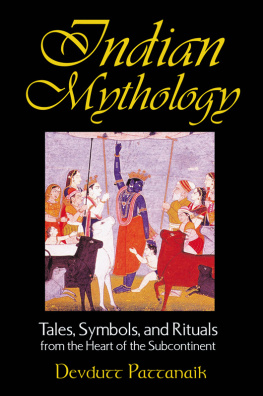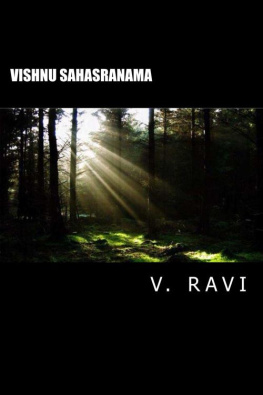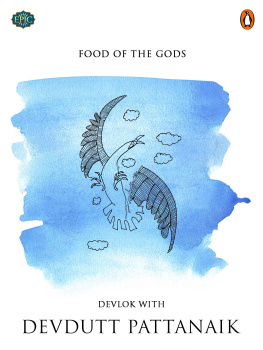7 S ECRETS OF
V ISHNU
Devdutt Pattanaik is a medical doctor by education, a leadership consultant by profession, and a mythologist by passion. He writes and lectures extensively on the relevance of stories, symbols and rituals in modern life. He has written over fifteen books which include 7 Secrets of Hindu Calendar Art (Westland), Myth=Mithya: A Handbook of Hindu Mythology (Penguin), Book of Ram (Penguin), Jaya: An Illustrated Retelling of the Mahabharata (Penguin).
To know more visit devdutt.com
7 Secrets of
Vishnu
Devdutt Pattanaik

westland ltd
Venkat Towers, 165, P.H. Road, Maduravoyal, Chennai 600 095
No. 38/10 (New No.5), Raghava Nagar, New Timber Yard Layout, Bangalore 560 026
Survey No. A - 9, II Floor, Moula Ali Industrial Area, Moula Ali, Hyderabad 500 040
23/181, Anand Nagar, Nehru Road, Santacruz East, Mumbai 400 055
4322/3, Ansari Road, Daryaganj, New Delhi 110 002
First published by westland ltd 2011
Copyright Devdutt Pattanaik 2011
All rights reserved
10 9 8 7 6 5 4 3 2 1
ISBN: 978-93-80658-68-1
Typeset and designed by Special Effects, Mumbai
Printed at Thomson Press (India) Ltd.
This book is sold subject to the condition that it shall not by way of trade or otherwise, be lent, resold, hired out, circulated, and no reproduction in any form, in whole or in part (except for brief quotations in critical articles or reviews) may be made without written permission of the publishers.
I humbly and most respectfully dedicate this book to
those hundreds of artists and artisans who made
sacred art so easily accessible to the common man
Contents
Authors Note
On Communicating Ideas
I t is significant that the stories of Vishnu rose to prominence after the rise of Buddhism. Prior to that, Hinduism was the religion of the elite-based complex rituals known as yagna and esoteric speculations captured in texts known as the Aranyakas and the Upanishads. These seemed very distant to the common man who focused on fertility rituals, worship of plants and animals and nature.
Buddhism spoke directly to the common man in the language of the people and addressed every day concerns. It naturally became very popular. But the Buddhist worldview leaned towards monasticism. By contrast, the Hindu worldview made room for both, the hermit and the householder. To fire the imagination of the people moving towards monasticism this had to be communicated using a tool that the masses relished stories.
Stories of Vishnu communicate the Hindu worldview from the point of view of the householder. This is complemented by stories of Shiva that communicate an equally valid but alternate viewpoint, that of the hermit. Since both Vishnu and Shiva were forms of God, both worldviews, that of the householder and that of the hermit, were held in equal regard.
To ensure that these stories were not reduced to entertainment, they were deemed sacred and anchored with symbols and rituals. The symbols and rituals of Vishnu are different from the symbols and rituals of Shiva. For example, Vishnu is visualised bedecked in gold while Shiva is worshipped smeared in ash; Vishnu is offered sprigs of the tulsi that is grown inside the house while Shiva is offered leaves of the bilva that is grown outside the house; Vishnu dances with his eyes open while Shiva dances with his eyes shut. Through these differences, different ideas were communicated.
Wisdom that was once restricted to a few now reached everyone who chose to hear the stories, look at the symbols, and perform the rituals. Vishnu represents a key figure in the new story-based Hinduism. He is a critical piece of what can be called the grand Hindu jigsaw puzzle.
To help readers unravel the secrets of Vishnu, the chapters have been arranged as below:
- The first chapter focuses on how gender is used to explain fundamental metaphysical concepts integral to Hinduism.
- The second chapter discusses the difference between man and animal.
- The third and fourth chapters focus on the Devas and the Asuras, both of whom are unhappy, as one struggles with insecurity and the other with ambition.
- The fifth and sixth chapters revolve around the Ramayana and Mahabharata, as man struggles with his humanity.
- The seventh chapter is about the wisdom of letting go with faith in renewal.
This book seeks to make explicit patterns that are implicit in stories, symbols and rituals of Vishnu firm in the belief that:
Within Infinite Truths lies the Eternal Truth
Who sees it all?
Varuna has but a thousand eyes
Indra, a hundred
And I, only two


A festival image or utsav-moorti of Vishnu as Mohini from a south Indian temple
M ohini is the female form of Vishnu. She is an enchantress, an alluring damsel, a temptress. But she is not a nymph, or Apsara, such as Menaka, Rambha and Urvashi, renowned in Hindu mythology for their ability to seduce sages and demons. Mohini stands apart because she is identified as Vishnu and Vishnu is conventionally visualised as male. Mohini is his female form.
Hindu mythology uses gender as a vehicle to communicate metaphysical ideas. A fundamental theme in Indian metaphysics is the existence of two realities: material reality and spiritual reality. Material reality is tangible reality that can be perceived through the senses. Spiritual reality is intangible reality that cannot be perceived through the senses. Material reality is represented using female form while spiritual reality is represented using male form.
Mohini is female in form but male in essence, unlike Apsaras who are totally female. Both enchant, but their intentions are different. An Apsara enchants to distract humanity from spiritual reality and entrap all in material reality. Mohini enchants to draw humanitys attention to spiritual reality within material reality. Mohini is thus spiritual reality wrapped in material reality. This is the central theme of Vishnu lore.

In metaphysics, material reality is known as prakriti, and spiritual reality is referred to as purusha. Prakriti means nature. Purusha means human.
Humans are accorded a special place in nature, over minerals, plants, and animals, because only humans have the ability to reflect, introspect, imagine and choose. All these qualities make it possible for humans to rise above physical limitations, transcend the boundaries of nature, and discover infinity. Human life is thus special. Therefore, the ancients represented both metaphysical principles using human symbols.

Vishnu and Lakshmi on the walls of a Khajuraho temple, built in 12th century, by Chandela kings
Material and spiritual reality are interdependent. Without material reality, spiritual reality cannot be discovered, and without spiritual reality, material reality has no purpose. This idea of complementary realities is expressed in Hindu mythology as a human couple. The interdependence of material and spiritual reality is best expressed through the interdependence of woman and man. This is the reason why temple walls are adorned with intimate conjugal images or dampatya.























